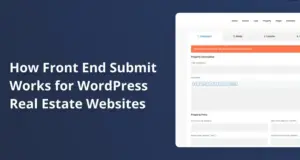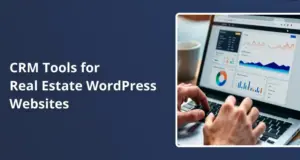Understanding the Function of Landing Pages
So, let’s kick things off by diving into the nuts and bolts of what landing pages really do. You might be wondering, “Are they like my homepage?” Nope! Landing pages are like the star players of your real estate website—they’re focused, single-minded, and have one goal: converting visitors into leads. They don’t have all the distractions of a website, like photos of your cat, Fluffy, or that funny meme you just have to share.
These pages are laser-focused on getting your visitors to do one thing: say “Yes!” Whether that’s downloading a buyer’s guide or signing up for a webinar, your landing page should guide them toward a single action you want them to take. Think of them as the bouncers of your club (a.k.a. your CRM)—checking IDs and making sure only the serious partygoers get in.
Want to see this in action? Picture a landing page offering a “List of Homes Coming Soon.” The potential buyer is already leaning in, probably thinking, “I want to see those homes now!” Before they dive in, you get their contact info, and boom! You’re set up for follow-up. This strategy works wonders because it’s clear, it’s simple, and it gives you leads who are ready to take action.
Keeping It Simple
Let’s talk about simplicity for a second. Have you ever opened a website and felt like you were stepping into a high-tech laboratory? Too many buttons, flashing lights, and don’t get me started on the tiny text that requires a magnifying glass. By contrast, your landing page should be as simple as a well-made Old Fashioned: clean, straightforward, and leaving your visitors wanting more.
Don’t make your visitors think too hard. Make the benefits of taking action clear and straightforward. You’re not just offering a guide—you’re offering peace of mind, a head start on the market, a competitive edge. Highlight these benefits front and center.
Now, let’s talk about CTAs (Call To Action, not Cute Turtles, though those are adorable). Make your CTA stand out like a single neon beer sign in a dark dive bar. Use a contrasting color, place it prominently on the page, and consider using action-oriented language like “Get My Free Guide” or “Unlock Exclusive Listings.”
Crafting Compelling Content
Ah, content. The bread and butter of your landing page. But not just any content—compelling content that grabs your visitors by the collar and says, “Read me!” Start with a strong, clear heading that answers the question on every buyer’s mind: “What’s in it for me?” Follow that up with concise, persuasive text that highlights the benefits of taking action. You’re not just selling a product; you’re selling a solution to their problem.
Don’t forget to include engaging visuals. We’re talking high-quality photos, eye-catching graphics, and maybe even a well-placed video that adds a personal touch. Visuals are like the sprinkles on your cupcake—nice to have, but essential for standing out in a crowded market.
And here’s a pro tip: social proof is everything. Include testimonials from satisfied clients, along with before-and-after photos if you’ve been doing any home renovations. Nothing builds trust faster than hearing how you transformed someone’s home and their life. It’s like a superhero story, but with less spandex.
Effective Use of Lead Capture Forms
Okay, we’re finally at the part where you capture all that sweet, sweet contact information. But wait—before you make your lead fill out a novel-length form, let’s talk strategy.
First off, only ask for what you really need: name, email, maybe a phone number. Anything more than that and you’re asking them to write their life story. This is about reducing friction—making it as easy as possible for someone to become a lead.
Also, consider implementing a double opt-in for email validation. This means your leads will need to check their inbox and click a confirmation link. It might seem like an extra step, but it’s crucial for ensuring you have a valid email address. Plus, it gives you one more chance to engage with your leads before they even get your emails.
Tools for Building Landing Pages
Now, let’s talk tools because you can’t build a house (or a landing page) without the right toolbox. There are a ton of options out there, but you need something that makes creating and managing these pages a breeze.
First up, consider using your CRM for landing pages. Many CRM platforms, like KV Core, already include powerful landing page builders as part of their offering. This integration means your leads are captured directly into your existing database, eliminating the need for juggling multiple platforms.
Prefer more control? WordPress website builders offer endless flexibility for tech-savvy agents who want to build landing pages directly on their site. Creating landing pages with the WpResidence theme for WordPress is straightforward and customizable, making it a great choice for real estate professionals. To get started, simply navigate to Pages in the WordPress dashboard and click Add New. You can use the WpResidence Page Builder or integrate with popular page builders like Elementor to drag and drop elements easily.
The theme offers customizable property sliders, contact forms, calls-to-action, and other built-in widgets tailored for real estate. You can also integrate advanced search features and Google Maps for displaying property locations.
Pro tip: Look for tools that also manage leads effectively, like property nurturing systems. This feature means you have one less thing to manage and can spend more time converting leads into clients.
Examples of Effective Landing Pages
Still not convinced about the power of landing pages? Let’s take a look at some real-world examples to spark your imagination.
In our hyper-competitive real estate market, you can’t just throw up any old landing page and expect leads to magically appear. You need to target specific goals and audiences with your landing pages to see any serious results.
Downloadable guides are a gold mine for lead generation. Create specialized guides that cater to different audiences: first-time homebuyers, luxury home seekers, investors, or downsizers. Remember to use attention-grabbing headlines that highlight the value, like “Ultimate Checklist for First-Time Homebuyers” or “10 Things Every Savvy Investor Knows.” Pair these with engaging visuals and a clear call to action, and you’re off to the races.
Property lists are another excellent option. Showcase listings that fit particular criteria, such as “Affordable Homes Under $300k” or “Historic Homes in Atlanta.” Pair these with stunning images, quick property stats, and a compelling call to action like “Be First to See New Listings.” You’ll not only capture leads interested in these properties, but you’ll also become a trusted resource in your niche.
Webinars can also be a highly effective lead-generating tool. Offer educational webinars on topics that matter to your audience, like “5 Mistakes First-Time Homebuyers Make” or “How to Maximize Your Home’s Value.” Promote these landing pages through social media and email marketing, and watch your list of interested leads grow.
With the right strategy, you can create landing pages that convert visitors into valuable leads and put your business on the fast track to success.
Promoting Your Landing Pages
It’s great to have killer landing pages, but if no one sees them, it’s like having a gorgeous listing without a sign in the yard. Promotion is key. Whether it’s social media, email, or good old-fashioned networking, get the word out!
Social media is a natural fit for your landing pages. Use clear, eye-catching CTAs that direct users back to your landing page, like “Download Now” or “Register Here.”
Don’t overlook targeted ads on platforms like Facebook, Google, and LinkedIn. These can be highly effective in reaching your target audience with your specific offers. And don’t forget to incorporate links to your landing pages in related blog posts. This strategy ensures you’re getting traffic from multiple sources, turning casual readers into potential leads.
Finally, make sure your entire content ecosystem is working toward the same goal. Every blog post, email campaign, and piece of content you create should have a purpose and a direction, leading users toward your desired action.
In a nutshell, your landing pages should be simple, focused, and compelling. Use lead capture forms to collect contact information, and take advantage of the right tools to build and promote your pages effectively. With these tips, you’ll be generating high-quality leads and growing your business in no time.
Happy selling!








